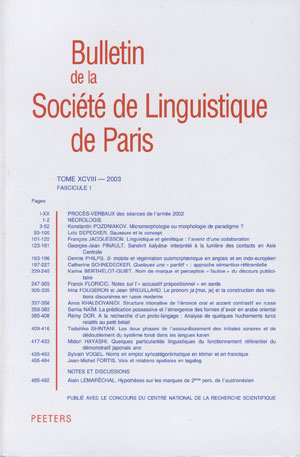 previous article in this issue previous article in this issue | next article in this issue  |

Preview first page |
Document Details : Title: L'identité catégorielle du participe passé en français contemporain Subtitle: Diversité des approches actuelles Author(s): JALENQUES, Pierre Journal: Bulletin de la Société de Linguistique de Paris Volume: 119 Date: 2024 Pages: 87-164 DOI: 10.2143/BSL.119.0.3294008 Abstract : Cet article reprend une question ancienne mais toujours d’actualité, à savoir le problème de l’identité catégorielle du participe passé (noté PP) en français. Dans une première partie, nous revenons sur les origines du PP, depuis le proto-indo-européen, afin de mettre en perspective les rapports historiques entre ses trois grandes classes d’emplois actuelles (dans les temps composés, au passif et en emploi nu). Dans une deuxième partie, nous proposons une clarification du débat autour des notions d’hybridité catégorielle et de polycatégorialité. Cette réflexion aboutit à une grille de classement des différentes analyses envisageables. Nous montrons dans une troisième partie que les conceptions sur l’identité catégorielle du PP restent très divergentes à l’heure actuelle, allant des approches selon lesquelles le PP est tantôt verbe tantôt adjectif au gré de ses emplois (refusant donc l’hybridité catégorielle) aux approches selon lesquelles le PP est à la fois verbe et adjectif pour tout ou partie de ses emplois (revendiquant l’hybridité catégorielle). À l’issue de ce parcours, il apparaît que les analyses catégorielles du PP en français sont généralement parcellaires, ne s’intéressant qu’à une partie de ses emplois (soit ses emplois dans les temps composés, soit ses emplois au passif soit ses emplois sans auxiliaire) ou bien ne s’intéressant qu’à une partie des faits (morphologiques ou syntaxiques ou sémantiques). Ce parcours des différentes analyses du PP (sans prétendre à l’exhaustivité) débouche sur un panorama général reprenant les principaux faits morphologiques, syntaxiques et sémantiques caractérisant le PP dans l’ensemble de ses emplois, ce dont devrait tenir compte toute nouvelle analyse catégorielle du PP. This article revisits an old but still topical question, namely the problem of the categorial status of the past participle (PastP) in French. In the first part, we look back at the origins of the PastP from Proto-Indo-European to put into perspective the historical relationships between its three main current uses (in compound tenses, in the passive and in bare use). In the second part, we propose a clarification of the debate around the notions of hybrid category and polycategoricality. This reflection leads to a classification grid of the various conceivable analyses. In the third part, we show that current conceptions of the categorial status of the PastP remain highly divergent, ranging from approaches that consider the PastP to be either a verb or an adjective depending on its uses (thus rejecting categorial hybridity) to approaches that consider the PastP to be both a verb and an adjective for all or part of its uses (advocating categorial hybridity). At the end of this survey, it appears that the categorial analyses of the PastP in French are generally incomplete, focusing only on some of its uses (either its uses in compound tenses, or its uses in the passive, or its uses without an auxiliary) or only on some aspects (morphological, syntactic or semantic) of the data. This survey of the different analyses of the PastP leads (without claiming to be exhaustive) to a general overview summarising the main morphological, syntactic and semantic facts characterising the PastP in all its uses, which should be taken into account in any new categorial analysis of the PastP. |
|


